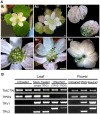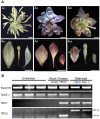Virus-induced gene silencing as a tool for comparative functional studies in Thalictrum
- PMID: 20706585
- PMCID: PMC2919395
- DOI: 10.1371/journal.pone.0012064
Virus-induced gene silencing as a tool for comparative functional studies in Thalictrum
Abstract
Perennial woodland herbs in the genus Thalictrum exhibit high diversity of floral morphology, including four breeding and two pollination systems. Their phylogenetic position, in the early-diverging eudicots, makes them especially suitable for exploring the evolution of floral traits and the fate of gene paralogs that may have shaped the radiation of the eudicots. A current limitation in evolution of plant development studies is the lack of genetic tools for conducting functional assays in key taxa spanning the angiosperm phylogeny. We first show that virus-induced gene silencing (VIGS) of a PHYTOENE DESATURASE ortholog (TdPDS) can be achieved in Thalictrum dioicum with an efficiency of 42% and a survival rate of 97%, using tobacco rattle virus (TRV) vectors. The photobleached leaf phenotype of silenced plants significantly correlates with the down-regulation of endogenous TdPDS (P<0.05), as compared to controls. Floral silencing of PDS was achieved in the faster flowering spring ephemeral T. thalictroides. In its close relative, T. clavatum, silencing of the floral MADS box gene AGAMOUS (AG) resulted in strong homeotic conversions of floral organs. In conclusion, we set forth our optimized protocol for VIGS by vacuum-infiltration of Thalictrum seedlings or dormant tubers as a reference for the research community. The three species reported here span the range of floral morphologies and pollination syndromes present in Thalictrum. The evidence presented on floral silencing of orthologs of the marker gene PDS and the floral homeotic gene AG will enable a comparative approach to the study of the evolution of flower development in this group.
Conflict of interest statement
Figures




Similar articles
-
Partial redundancy and functional specialization of E-class SEPALLATA genes in an early-diverging eudicot.Dev Biol. 2016 Nov 1;419(1):143-155. doi: 10.1016/j.ydbio.2016.07.021. Epub 2016 Aug 6. Dev Biol. 2016. PMID: 27502434
-
Sub-functionalization to ovule development following duplication of a floral organ identity gene.Dev Biol. 2015 Sep 1;405(1):158-72. doi: 10.1016/j.ydbio.2015.06.018. Epub 2015 Jun 27. Dev Biol. 2015. PMID: 26123745
-
TRV-GFP: a modified Tobacco rattle virus vector for efficient and visualizable analysis of gene function.J Exp Bot. 2014 Jan;65(1):311-22. doi: 10.1093/jxb/ert381. Epub 2013 Nov 11. J Exp Bot. 2014. PMID: 24218330 Free PMC article.
-
An Overview of Molecular Basis and Genetic Modification of Floral Organs Genes: Impact of Next-Generation Sequencing.Mol Biotechnol. 2023 Jun;65(6):833-848. doi: 10.1007/s12033-022-00633-7. Epub 2022 Dec 22. Mol Biotechnol. 2023. PMID: 36544065 Review.
-
MADS-box genes and floral development: the dark side.J Exp Bot. 2012 Sep;63(15):5397-404. doi: 10.1093/jxb/ers233. Epub 2012 Aug 21. J Exp Bot. 2012. PMID: 22915743 Review.
Cited by
-
Virus-induced gene silencing (VIGS) in Lilium leichtlinii using the Cucumber mosaic virus vector.Plant Biotechnol (Tokyo). 2016;33(5):373-381. doi: 10.5511/plantbiotechnology.16.1018a. Epub 2016 Nov 26. Plant Biotechnol (Tokyo). 2016. PMID: 31274998 Free PMC article.
-
Poppy APETALA1/FRUITFULL orthologs control flowering time, branching, perianth identity, and fruit development.Plant Physiol. 2012 Apr;158(4):1685-704. doi: 10.1104/pp.111.192104. Epub 2012 Jan 27. Plant Physiol. 2012. PMID: 22286183 Free PMC article.
-
An Efficient Virus-Induced Gene Silencing System for Functional Genomics Research in Walnut (Juglans regia L.) Fruits.Front Plant Sci. 2021 Jun 23;12:661633. doi: 10.3389/fpls.2021.661633. eCollection 2021. Front Plant Sci. 2021. PMID: 34249033 Free PMC article.
-
Low temperature-induced DNA hypermethylation attenuates expression of RhAG, an AGAMOUS homolog, and increases petal number in rose (Rosa hybrida).BMC Plant Biol. 2015 Oct 5;15:237. doi: 10.1186/s12870-015-0623-1. BMC Plant Biol. 2015. PMID: 26438149 Free PMC article.
-
A virus-induced gene silencing approach to understanding alkaloid metabolism in Catharanthus roseus.Phytochemistry. 2011 Nov;72(16):1969-77. doi: 10.1016/j.phytochem.2011.07.001. Epub 2011 Jul 27. Phytochemistry. 2011. PMID: 21802100 Free PMC article.
References
-
- Tamura M. Ranunculaceae. In: Hiepko P, editor. Die Naturlichen Pflanzenfamilien. Berlin: Duncker & Humblot; 1995. pp. 223–497.
-
- Pellmyr O. Pollination biology. In: Hiepko P, editor. Die Naturlichen Pflanzenfamilien, Ranunculaceae. 2nd ed. Berlin: Duncker & Humblot; 1995. pp. 160–184.
-
- Lutskii V, Gromova A, Khamidullina E, Owen N. Structural Studies and Biological Activity of Plant Triterpenoids from the Thalictrum Genus. Chemistry of Natural Compounds. 2005;41:117–140.
-
- Khamidullina EA, Gromova AS, Lutsky VI, Owen NL. Natural products from medicinal plants: non-alkaloidal natural constituents of the Thalictrum species. Nat Prod Rep. 2006;23:117–129. - PubMed
-
- Liscombe DK, Ziegler J, Schmidt J, Ammer C, Facchini PJ. Targeted metabolite and transcript profiling for elucidating enzyme function: isolation of novel N-methyltransferases from three benzylisoquinoline alkaloid-producing species. Plant J. 2009;60:729–743. - PubMed
Publication types
MeSH terms
Substances
LinkOut - more resources
Full Text Sources
Other Literature Sources
Miscellaneous

